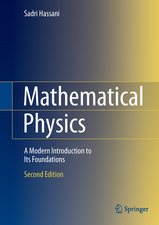Mathematical Methods: For Students of Physics and Related Fields
Autor Sadri Hassanien Limba Engleză Paperback – 27 oct 2008
Beginning with reviews of vector algebra and differential and integral calculus, the book continues with infinite series, vector analysis, complex algebra and analysis, ordinary and partial differential equations. Discussions of numerical analysis, nonlinear dynamics and chaos, and the Dirac delta function provide an introduction to modern topics in mathematical physics.
This new edition has been made more user-friendly through organization into convenient, shorter chapters. Also, it includes an entirely new section on Probability and plenty of new material on tensors and integral transforms.
| Toate formatele și edițiile | Preț | Express |
|---|---|---|
| Paperback (1) | 621.72 lei 6-8 săpt. | |
| Springer – 27 oct 2008 | 621.72 lei 6-8 săpt. | |
| Hardback (1) | 770.55 lei 6-8 săpt. | |
| Springer – 27 oct 2008 | 770.55 lei 6-8 săpt. |
Preț: 621.72 lei
Preț vechi: 731.43 lei
-15% Nou
Puncte Express: 933
Preț estimativ în valută:
118.100€ • 123.76$ • 99.72£
118.100€ • 123.76$ • 99.72£
Carte tipărită la comandă
Livrare economică 14-28 martie
Preluare comenzi: 021 569.72.76
Specificații
ISBN-13: 9781493937127
ISBN-10: 149393712X
Pagini: 832
Ilustrații: XXIII, 832 p.
Dimensiuni: 178 x 254 x 43 mm
Greutate: 1.47 kg
Ediția:2nd ed. 2009
Editura: Springer
Colecția Springer
Locul publicării:New York, NY, United States
ISBN-10: 149393712X
Pagini: 832
Ilustrații: XXIII, 832 p.
Dimensiuni: 178 x 254 x 43 mm
Greutate: 1.47 kg
Ediția:2nd ed. 2009
Editura: Springer
Colecția Springer
Locul publicării:New York, NY, United States
Cuprins
Coordinates and Calculus.- Coordinate Systems and Vectors.- Differentiation.- Integration: Formalism.- Integration: Applications.- Dirac Delta Function.- Algebra of Vectors.- Planar and Spatial Vectors.- Finite-Dimensional Vector Spaces.- Vectors in Relativity.- Infinite Series.- Infinite Series.- Application of Common Series.- Integrals and Series as Functions.- Analysis of Vectors.- Vectors and Derivatives.- Flux and Divergence.- Line Integral and Curl.- Applied Vector Analysis.- Curvilinear Vector Analysis.- Tensor Analysis.- Complex Analysis.- Complex Arithmetic.- Complex Derivative and Integral.- Complex Series.- Calculus of Residues.- Differential Equations.- From PDEs to ODEs.- First-Order Differential Equations.- Second-Order Linear Differential Equations.- Laplace’s Equation: Cartesian Coordinates.- Laplace’s Equation: Spherical Coordinates.- Laplace’s Equation: Cylindrical Coordinates.- Other PDEs of Mathematical Physics.- Special Topics.- Integral Transforms.- Calculus of Variations.- Nonlinear Dynamics and Chaos.- Probability Theory.
Recenzii
From the reviews of the second edition:
"The book has many strengths. For example: Each chapter starts with a preamble that puts the chapters in context. Often, the author uses physical examples to motivate definitions, illustrate relationships, or culminate the development of particular mathematical strands. The use of Maxwell's equations to cap the presentation of vector calculus, a discussion that includes some tidbits about what led Maxwell to the displacement current, is a particularly enjoyable example. Historical touches like this are not isolated cases; the book includes a large number of notes on people and ideas, subtly reminding the student that science and mathematics are continuing and fascinating human activities." --Physics Today
"Very well written (i.e., extremely readable), very well targeted (mainly to an average student of physics at a point of just leaving his/her sophomore level) and very well concentrated (to an author's apparently beloved subject of PDE's with applications and with all their necessary pedagogically-mathematical background)...The main merits of the text are its clarity (achieved via returns and innovations of the context), balance (building the subject step by step) and originality (recollect: the existence of the complex numbers is only admitted far in the second half of the text!). Last but not least, the student reader is impressed by the graphical quality of the text (figures first of all, but also boxes with the essentials, summarizing comments in the left column etc.)...Summarizing: Well done." --Zentralblatt MATH
"This new edition … of Mathematical Methods is designed to be used in an upper-division undergraduate course for physics and engineering majors. … The order of presentation is particularly good. … An additional strength of the book is the inclusion of chapters on nonlinear dynamics and probability. These chapters give a good introduction to chaos theory and the basic concepts ofprobability for beginning statistical mechanics students. … Overall, the volume is well written … . Summing Up: Highly recommended. Upper-division undergraduates." (E. Kincanon, Choice, Vol. 46 (8), April, 2009)
"The purpose of this book is to provide a comprehensive survey of the mathematics underlying theoretical physics at the level of graduate students entering research … . It is also intended to serve the research scientist or engineer who needs a quick refresher course in the subject … . This volume is intended to help bridge the wide gap separating the level of mathematical sophistication expected of students of introductory physics from that expected of students of advanced courses of undergraduate physics and engineering." (Teodora-Liliana Radulescu, Zentrablatt MATH, Vol. 1153, 2009)
"The book has many strengths. For example: Each chapter starts with a preamble that puts the chapters in context. Often, the author uses physical examples to motivate definitions, illustrate relationships, or culminate the development of particular mathematical strands. The use of Maxwell's equations to cap the presentation of vector calculus, a discussion that includes some tidbits about what led Maxwell to the displacement current, is a particularly enjoyable example. Historical touches like this are not isolated cases; the book includes a large number of notes on people and ideas, subtly reminding the student that science and mathematics are continuing and fascinating human activities." --Physics Today
"Very well written (i.e., extremely readable), very well targeted (mainly to an average student of physics at a point of just leaving his/her sophomore level) and very well concentrated (to an author's apparently beloved subject of PDE's with applications and with all their necessary pedagogically-mathematical background)...The main merits of the text are its clarity (achieved via returns and innovations of the context), balance (building the subject step by step) and originality (recollect: the existence of the complex numbers is only admitted far in the second half of the text!). Last but not least, the student reader is impressed by the graphical quality of the text (figures first of all, but also boxes with the essentials, summarizing comments in the left column etc.)...Summarizing: Well done." --Zentralblatt MATH
"This new edition … of Mathematical Methods is designed to be used in an upper-division undergraduate course for physics and engineering majors. … The order of presentation is particularly good. … An additional strength of the book is the inclusion of chapters on nonlinear dynamics and probability. These chapters give a good introduction to chaos theory and the basic concepts ofprobability for beginning statistical mechanics students. … Overall, the volume is well written … . Summing Up: Highly recommended. Upper-division undergraduates." (E. Kincanon, Choice, Vol. 46 (8), April, 2009)
"The purpose of this book is to provide a comprehensive survey of the mathematics underlying theoretical physics at the level of graduate students entering research … . It is also intended to serve the research scientist or engineer who needs a quick refresher course in the subject … . This volume is intended to help bridge the wide gap separating the level of mathematical sophistication expected of students of introductory physics from that expected of students of advanced courses of undergraduate physics and engineering." (Teodora-Liliana Radulescu, Zentrablatt MATH, Vol. 1153, 2009)
Textul de pe ultima copertă
Intended to follow the usual introductory physics courses, this book has the unique feature of addressing the mathematical needs of sophomores and juniors in physics, engineering and other related fields. Many original, lucid, and relevant examples from the physical sciences, problems at the ends of chapters, and boxes to emphasize important concepts help guide the student through the material.
Beginning with reviews of vector algebra and differential and integral calculus, the book continues with infinite series, vector analysis, complex algebra and analysis, ordinary and partial differential equations. Discussions of numerical analysis, nonlinear dynamics and chaos, and the Dirac delta function provide an introduction to modern topics in mathematical physics.
This new edition has been made more user-friendly through organization into convenient, shorter chapters. Also, it includes an entirely new section on Probability and plenty of new material on tensors and integral transforms.
Some praise for the previous edition:
"The book has many strengths. For example: Each chapter starts with a preamble that puts the chapters in context. Often, the author uses physical examples to motivate definitions, illustrate relationships, or culminate the development of particular mathematical strands. The use of Maxwell's equations to cap the presentation of vector calculus, a discussion that includes some tidbits about what led Maxwell to the displacement current, is a particularly enjoyable example. Historical touches like this are not isolated cases; the book includes a large number of notes on people and ideas, subtly reminding the student that science and mathematics are continuing and fascinating human activities."
--Physics Today
"Very well written (i.e., extremely readable), very well targeted (mainly to an average student of physics at a point of just leaving his/her sophomore level) and very well concentrated (to an author's apparently beloved subject of PDE's with applications and with all their necessary pedagogically-mathematical background)...The main merits of the text are its clarity (achieved via returns and innovations of the context), balance (building the subject step by step) and originality (recollect: the existence of the complex numbers is only admitted far in the second half of the text!). Last but not least, the student reader is impressed by the graphical quality of the text (figures first of all, but also boxes with the essentials, summarizing comments in the left column etc.)...Summarizing: Well done."
--Zentralblatt MATH
Beginning with reviews of vector algebra and differential and integral calculus, the book continues with infinite series, vector analysis, complex algebra and analysis, ordinary and partial differential equations. Discussions of numerical analysis, nonlinear dynamics and chaos, and the Dirac delta function provide an introduction to modern topics in mathematical physics.
This new edition has been made more user-friendly through organization into convenient, shorter chapters. Also, it includes an entirely new section on Probability and plenty of new material on tensors and integral transforms.
Some praise for the previous edition:
"The book has many strengths. For example: Each chapter starts with a preamble that puts the chapters in context. Often, the author uses physical examples to motivate definitions, illustrate relationships, or culminate the development of particular mathematical strands. The use of Maxwell's equations to cap the presentation of vector calculus, a discussion that includes some tidbits about what led Maxwell to the displacement current, is a particularly enjoyable example. Historical touches like this are not isolated cases; the book includes a large number of notes on people and ideas, subtly reminding the student that science and mathematics are continuing and fascinating human activities."
--Physics Today
"Very well written (i.e., extremely readable), very well targeted (mainly to an average student of physics at a point of just leaving his/her sophomore level) and very well concentrated (to an author's apparently beloved subject of PDE's with applications and with all their necessary pedagogically-mathematical background)...The main merits of the text are its clarity (achieved via returns and innovations of the context), balance (building the subject step by step) and originality (recollect: the existence of the complex numbers is only admitted far in the second half of the text!). Last but not least, the student reader is impressed by the graphical quality of the text (figures first of all, but also boxes with the essentials, summarizing comments in the left column etc.)...Summarizing: Well done."
--Zentralblatt MATH
Caracteristici
Includes many original, lucid, and relevant examples from the physical sciences, problems at the ends of chapters, and boxes to emphasize important concepts Broad scope will be useful for students across a wide range of fields such as physics, engineering, and mathematics Substantially revised edition features new sections on Tensors, Integral Transforms, Calculus of Variations, and Probability Theory















